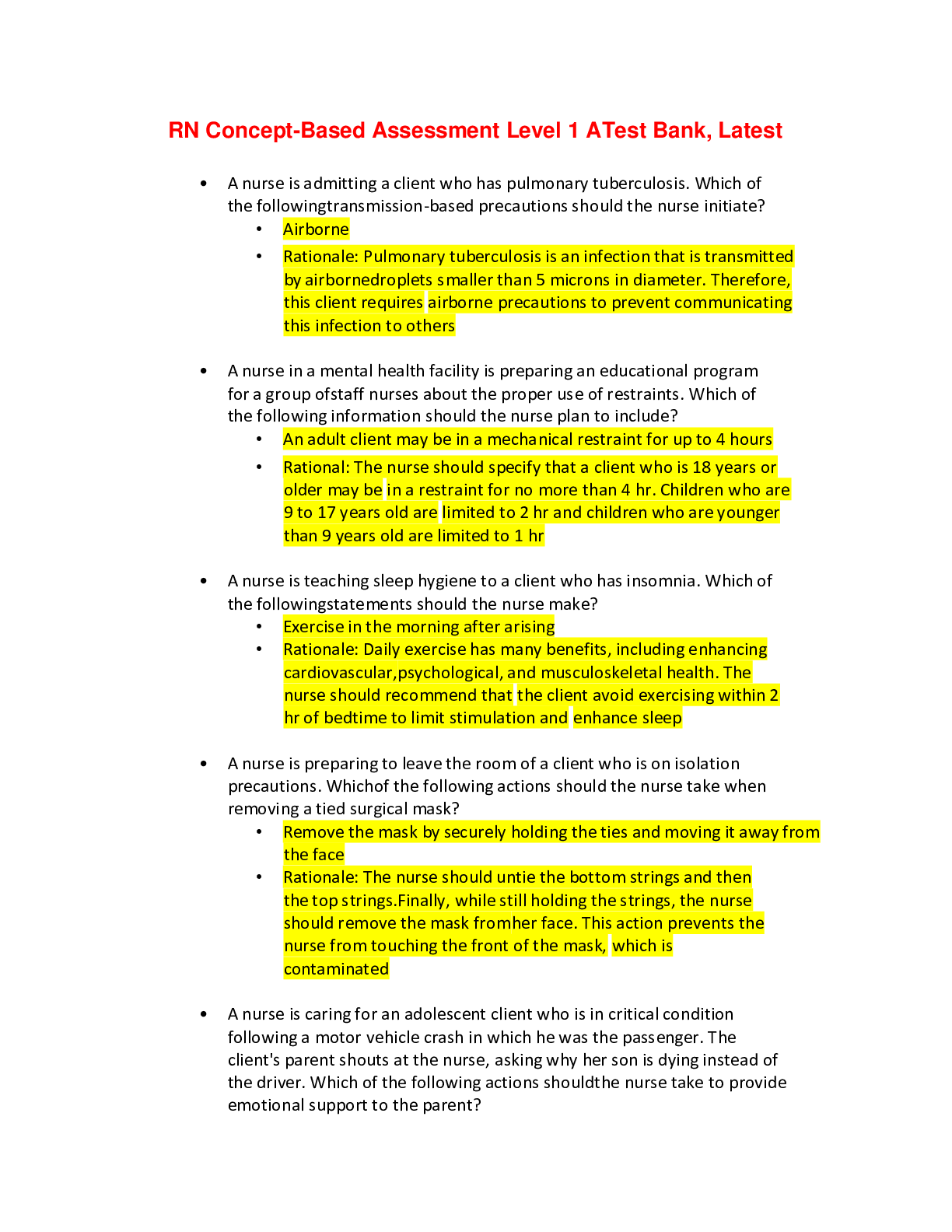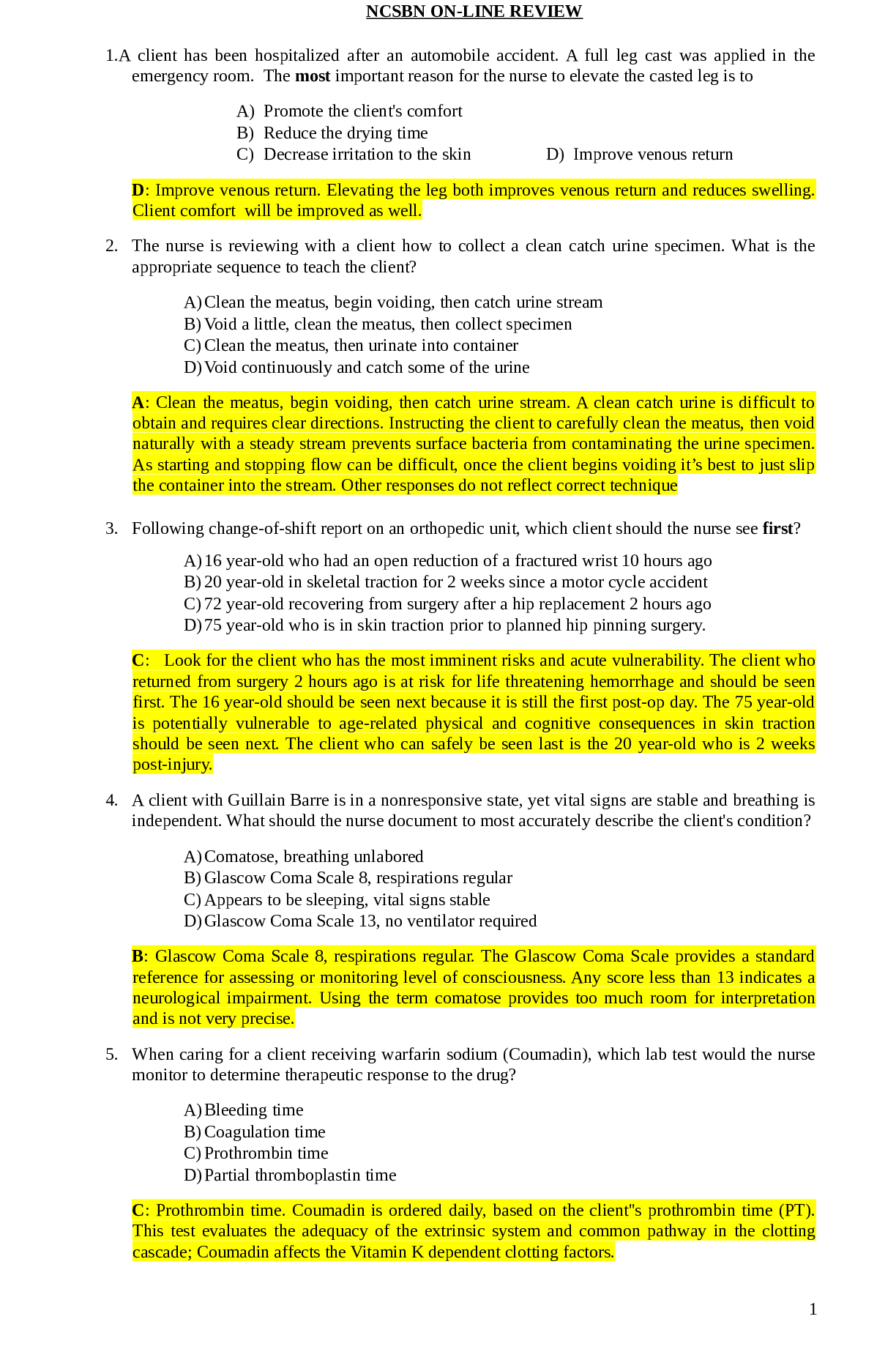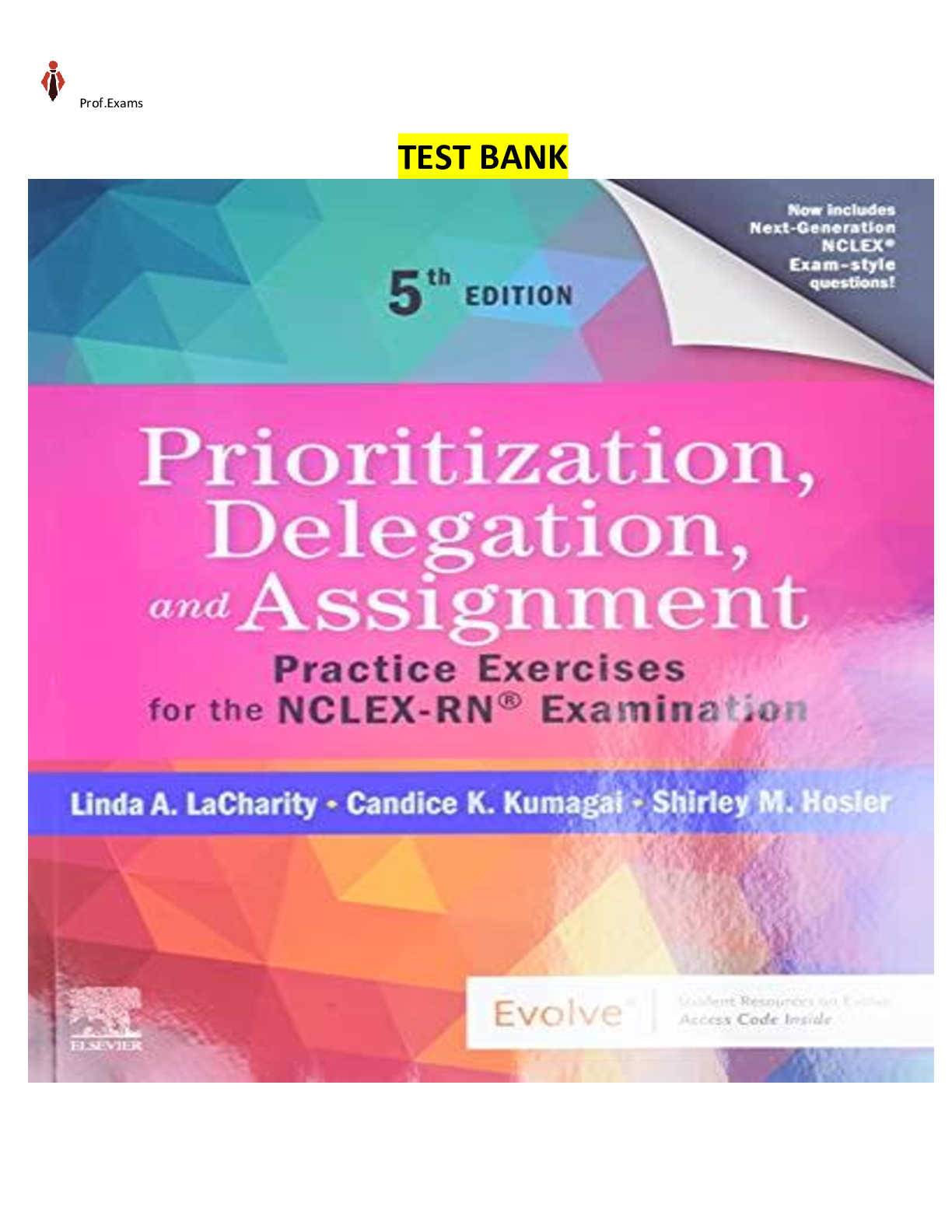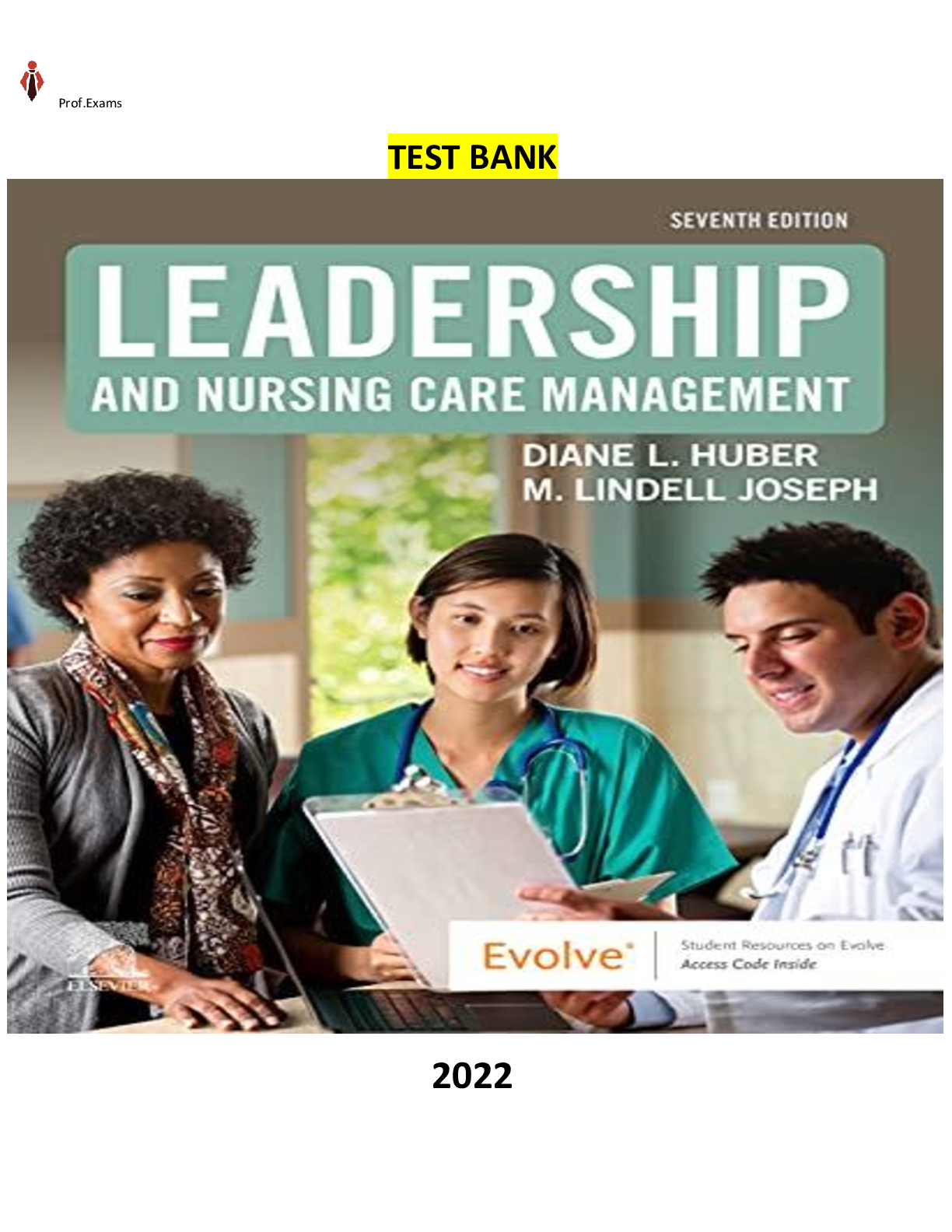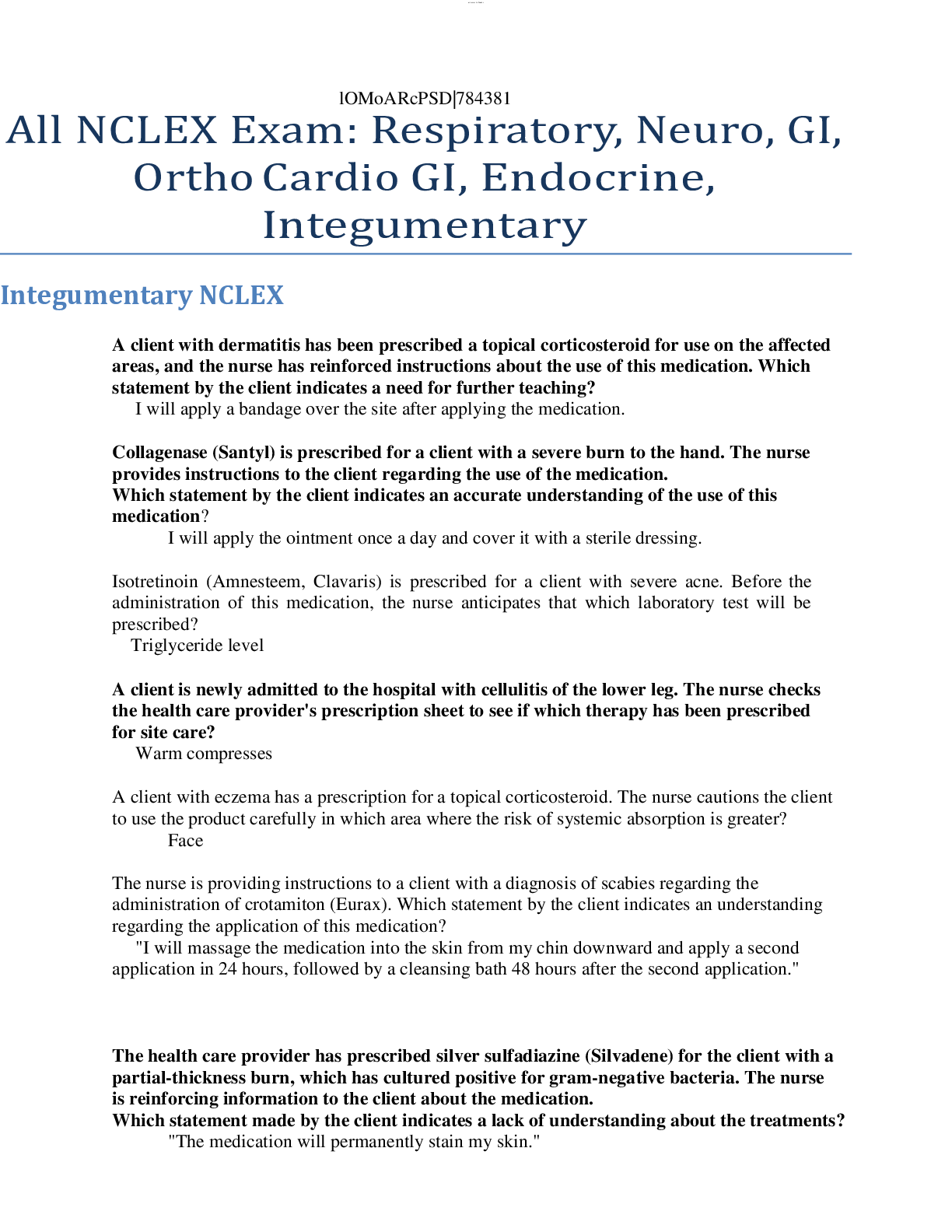*NURSING > TEST BANK > Chapter 12: NURS 340 Preparation For The Nclex Questions and Answers Test Bank ,100% CORRECT (All)
Chapter 12: NURS 340 Preparation For The Nclex Questions and Answers Test Bank ,100% CORRECT
Document Content and Description Below
Chapter 12: NURS 340 Preparation For The Nclex Questions and Answers Test Bank Origin: Chapter 12, 1 1. The nurse is teaching a group of parents with premature infants about the various medical and... developmental problems that may occur. The nurse determines that additional teaching is needed when the group identifies what as a problem? A) Sudden infant death syndrome B) Hydrocephalus C) Peptic ulcer D) Bronchopulmonary dysplasia Ans: C Feedback: Gastroesophageal reflux disease, not peptic ulcer, is a medical problem that commonly affects premature infants. Myriad problems may occur, including sudden infant death syndrome, hydrocephalus, bronchopulmonary dysplasia, cardiac changes, growth retardation, nutrient deficiencies, bradycardia, rickets, inguinal or umbilical hernias, visual problems, hearing deficits, delayed dentition, and growth delays. Origin: Chapter 12, 2 2. The nurse is caring for a toddler with special needs. Which developmental tasks related to toddlerhood might be delayed in the child with special needs? A) Developing body image B) Developing peer relationships C) Developing language and motor skills D) Learning through sensorimotor exploration Ans: C Feedback: In special needs children, developmental delays may occur in all stages. In particular, motor and language skill development may be delayed if the toddler is not given adequate opportunities to test his or her limits and abilities. Development of body image may be hindered in the preschooler due to painful exposures and anxiety. Development of peer relationships may be delayed in the school-age and adolescent child. The infant's ability to learn through sensorimotor exploration may be impaired due to lack of appropriate stimulation, confinement to a crib, or increased contact with painful experiences. Origin: Chapter 12, 3 3. The nurse is providing home care for a 1-year-old girl who is technologically dependent. Which intervention will best support the family process? A) Finding an integrated health program for the family B) Teaching modifications of the medical regimen for vacation C) Assessing family expectations for the special needs child D) Creating schedules for therapies and interventions Ans: D Feedback: Coordinating care with the schedules and capabilities of the parents provides the greatest support for the family. It gives them a sense of order and control. Integrated health care programs may not be available in the family's area. Teaching therapy modifications for travel and assessing family expectations are not supportive interventions. Origin: Chapter 12, 4 4. The nurse is caring for families with vulnerable child syndrome. Which situation would be most likely to predispose the family to this condition? A) Having a postterm infant B) Having an infant who is reluctant to feed properly C) Having a child diagnosed with impetigo at age 10 D) Having a child with juvenile diabetes Ans: B Feedback: "Vulnerable child syndrome" is a clinical state in which the parents' reactions to a serious illness or event in the child's past continue to have long-term psychologically harmful effects on the child and parents for many years. Risk factors for the development of vulnerable child syndrome include preterm birth, congenital anomaly, newborn jaundice, handicapping condition, an accident or illness that the child was not expected to recover from, or crying or feeding problems in the first 5 years of life. Origin: Chapter 12, 5 5.A 7-year-old boy has reentered the hospital for the second time in a month. Which intervention is particularly important at this time? A) Assessing his parents' coping abilities B) Seeking his parents' input about their child's needs C) Educating his family about the procedure D) Notifying the care team about his hospitalization Ans: A Feedback: Transition times, such as when the child reenters the hospital, create additional stress on the parents and child. Assessing the parents' coping abilities is particularly important at this time. Seeking parental input, educating about a procedure, and notifying the care team are basic activities of family-centered care and care coordination. Origin: Chapter 12, 6 6. The nurse is caring for a special needs infant. Which intervention will be most important in helping the child reach her maximum developmental potential? A) Directing her parents to an early intervention program B) Monitoring her progress in elementary school C) Serving on an individualized education program committee D) Preparing a plan for her to transition to college Ans: A Feedback: Early intervention is critical to maximizing the child's developmental potential by laying the foundation for health and development. While important, intervention in elementary or secondary school does not have the impact of early intervention. When the time arrives, it is important to have a written plan for transition to college, if this is a possibility for the grown child. Origin: Chapter 12, 7 7. The nurse is caring for a 4-year-old girl with special care needs in the hospital. Which intervention would have the most positive effect on this child? A) Taking her on an adventure down the hall B) Helping her do a simple craft project C) Introducing her to children in the playroom D) Limiting the staff providing care for her Ans: A Feedback: Preschool-age children need to develop a sense of initiative, and helping the child to explore her area of the hospital would help accomplish this developmental need. Craft projects and introducing the child to other children would help build a sense of industry and peer relationships, both of which are needs of the school-age, not preschool, child. Limiting the number of people providing care is a trust-building intervention, beginning in infancy. Origin: Chapter 12, 8 8. The nurse is caring for infants having the condition failure to thrive (FTT). Which infants would be at risk for this condition? Select all that apply. A) A newborn baby with tetralogy of Fallot B) An infant with a cleft palate C) An infant born to a diabetic mother D) An infant born to an impoverished mother E) An infant with bronchopulmonary dysplasia F) An infant born to a teenage mother Ans: A, B, D, E Feedback: Infants and children with cardiac or metabolic disease, chronic lung disease (bronchopulmonary dysplasia), cleft palate, or gastroesophageal reflux disease are at particular risk for FTT. Also, poverty is the single greatest contributing risk factor (Block et al., 2005). An infant born to a diabetic mother or an infant born to a teenage mother does not have increased risk for FTT. Origin: Chapter 12, 9 9. The nurse is weighing an underweight infant diagnosed with failure to thrive (FTT) and notes that the baby does not make eye contact and is less active than the other infants. What would be a probable cause for the FTT related to the infant's body language? A) Congenital heart defect B) Cleft palate C) Gastroesophageal reflux disease D) Maternal abuse Ans: D Feedback: Infants with FTT related to maternal neglect may avoid eye contact and be less interactive than other infants. Inorganic causes of FTT include neglect, abuse, behavioral problems, lack of appropriate maternal interaction, poor feeding techniques, lack of parental knowledge, or parental mental illness. Origin: Chapter 12, 10 10. Which would be least appropriate to include in the discharge plan for a medically fragile child? A) Assisting with referrals for financial support B) Arranging for necessary care equipment and supplies C) Assessing the family's home environment D) Encouraging passive caregiving Ans: D Feedback: As part of the discharge plan for a medically fragile child, the nurse would encourage active caregiving by the parents to help them increase their self-confidence in the child's care. Assisting with referrals, arranging for equipment and supplies, and determining the adequacy of the home environment are important aspects of the discharge plan. Origin: Chapter 12, 11 11. The nurse is looking into the Individuals with Disabilities Education Improvement Act of 2004 to help provide resources for a client with multiple chronic diseases. What are mandates of this legislation? Select all that apply. A) The law mandates government-funded care coordination and special education for children up to 8 years of age. B) This early intervention program is a state-funded program run at the federal level. C) This federal law allows each state to define "developmental disability" differently. D) An evaluation of the child's physical, language, emotional, and social capabilities is performed to determine eligibility. E) The primary care nurse manages the developmental services and special education that the child requires. F) The goal is to maintain a natural environment, so most services occur in the home or day care center. Ans: C, D, F Feedback: The Individuals with Disabilities Education Improvement Act of 2004 mandates government-funded care coordination and special education for children up to 3 years of age. Federal law allows each state to define "developmental disability" differently, but in general an evaluation of the child's physical, language, emotional, and social capabilities is performed by qualified personnel to determine eligibility. The goal of the program is that the child receives services in a "natural environment," so most services occur in the home or day care center. This early intervention program is administered through each state. Children who qualify for services receive care coordination, and the service coordinator manages the developmental services and special education that the child requires. Origin: Chapter 12, 12 12. The nurse is reviewing the Adolescent Health Transition Project's recommended schedule for transition planning. According to the schedule, at what age should the nurse explore health care financing for young adults? A) 12 years old B) 14 years old C) 17 years old D) 19 years old Ans: C Feedback: By age 14, the nurse should ensure that a transition plan is initiated and that the individualized education plan (IEP) reflects post–high school plans. By age 17, the nurse should explore health care financing for young adults. The nurse should check the teen's eligibility for Supplemental Security Income (SSI) the month the child turns 18. By age 21, the nurse should ensure that the young adult has registered with the Division of Developmental Disabilities for adult services if applicable. Origin: Chapter 12, 13 13. The nurse is caring for a 14-year-old girl with special health needs. What is the priority intervention for this child? A) Encouraging the parents to promote the child's self-care B) Assessing the child for signs of depression C) Discussing how her care will change as she grows D) Monitoring for compliance with treatment Ans: D Feedback: The priority intervention is monitoring for compliance with treatment. The girl is struggling to fit in with her peers and may try to hide or ignore her illness. Monitoring for depression and encouraging self-care have a lesser impact on the child's physical health. A transition plan to adulthood may be initiated some time in midadolescence. Origin: Chapter 12, 14 14. The nurse is helping a 20-year-old woman transition to adult care. Which would be the most important role of the nurse following a successful transition? A) Teacher B) Consultant C) Care provider D) Advocate Ans: B Feedback: Transition planning involves multidisciplinary care coordination; acknowledgement of the changing roles among the youth, family, and health care professionals; and fostering of the youth's self-determination skills. Prior to transition, educating the client is the most important role of the nurse. After the transition, the nurse serves as a consultant to the adult office in relation to the teen's needs. The nurse consults with a transition services coordinator or other service agency as available in the local community. Origin: Chapter 12, 15 15. The nurse caring for young children in a hospice setting is aware of the following statistics related to the occurrence of death in children. Which statement accurately reflects one of these statistics? A) Each year, about 50,000 children die in the United States; of those, about 15,000 are infants. B) It is unusual for a child's chronic illness to progress to the point of becoming a terminal illness. C) Despite strides made, diabetes remains the leading cause of death from disease in all children older than the age of 1 year. D) Congenital defects and traumatic injuries are the more common causes of diseases leading to death. Ans: D Feedback: Diseases can lead to terminal illness in children, with congenital defects and traumatic injuries being the more common causes. Each year, about 45,000 children die in the United States; of those, about 24,500 are infants (Heron et al., 2013). In many cases, a child's chronic illness may progress to the point of becoming a terminal illness. Cancer remains the leading cause of death from disease in all children older than the age of 1 year (Heron et al., 2013). Origin: Chapter 12, 16 16. The nurse is providing home care for the family of an 8-year-old boy who is dying of leukemia. Which action will be most supportive to the parents of the child? A) Encouraging organ and tissue donation B) Being patient with parental indecision C) Getting prior authorization for treatments D) Explaining how anorexia is a natural process Ans: B Feedback: It is critical to be patient with parents who may vacillate when making decisions. Give them the information and time they need to make decisions and avoid being judgmental. Explaining about anorexia and encouraging organ donation may be discussed when the parents indicate they are concerned. Getting prior authorization facilitates care delivery and is not a supportive intervention. Origin: Chapter 12, 17 17. The nurse is providing palliative care for a 9-year-old boy in hospice. Which is unique to hospice care for children? A) Encouraging visits from friends and family B) Educating parents about terminal dehydration C) Prolonging treatment that might possibly help D) Treating constipation to relieve abdominal pain Ans: C Feedback: Hospice for children allows for continuation of hopeful treatment so long as certain criteria are met. This is different from adult hospice. Encouraging visits from friends and family, educating parents about terminal dehydration, and treating constipation are common to family-centered care. Origin: Chapter 12, 18 18. When providing care to a dying child and his family, which would be most important? A) Focusing on the family as the unit of care B) Teaching the family appropriate care measures C) Offering the child support and encouragement D) Assisting the parents in decision making Ans: A Feedback: When caring for a dying child and his family, the most important aspect of care is focusing on the family as the unit of care. Teaching, offering support, and assisting in decision making are important, but these actions must be implemented while focusing on the family as the unit of care. Origin: Chapter 12, 19 19. The parents of an 11-year-old boy who is dying from cancer are concerned that he is not eating. Which intervention would serve both the parents' and child's needs? A) Urging the child to eat one good meal per day B) Serving small meals of things the child likes C) Straightening up around the child before meals D) Administering antiemetics as ordered for nausea Ans: B Feedback: The child is more likely to eat small amounts of foods of his choosing. This accommodates the child's reduced appetite, reassures his parents that he is not starving, and gives the child a sense of control. Straightening up the child's area before meals provides a more pleasant eating environment. The use of antiemetics controls nausea but may not increase appetite. Urging the child to eat a substantial meal is unnecessary and creates stress. Origin: Chapter 12, 20 20. The nurse is caring for a child involved in an automobile accident whose family has been informed that the child is brain dead. What teaching might the nurse provide the family regarding organ donation? A) The nurse should ask about organ donation when the family is informed of their child's condition. B) The nurse should explain that written consent is necessary for the organ donation. C) The nurse should make sure the parents know that procurement of organs may mar their child's appearance. D) The nurse should make sure the parents know that they will be responsible for expenses related to organ procurement. Ans: B Feedback: Written consent is necessary for organ donation, so the family must be appropriately informed and educated. The discussion of organ donation should be separate from the discussion of impending death or brain death notification. Families need to know that procurement of the organs does not mar the child's appearance, so that an open casket at the child's funeral is still possible if the family desires. All expenses for organ procurement are borne by the recipient's family, not the donor's. Origin: Chapter 12, 21 21. The nurse is caring for a preschool child who is receiving palliative care for end-stage cancer. What would be the focus of age-appropriate interventions for this child? A) Providing unconditional love and trust B) Providing a familiar and consistent routine C) Teaching the child that death is not punishment D) Providing specific, honest details of death Ans: C Feedback: Spirituality in the preschool years focuses on the concept of right versus wrong. The 3- to 5-year-old may see death as punishment for wrongdoing, and the nurse must correct this misunderstanding. For the infant, unconditional love and trust are of utmost importance. The toddler, 1 to 3 years old, thrives on familiarity and routine; the nurse should maximize the toddler's time with parents, be consistent, provide favorite toys, and ensure physical comfort. The school-age child has a concrete understanding of death. Children who are 5 to 10 years old need specific, honest details (as desired). Origin: Chapter 12, 22 22. The nurse is caring for a 5-year-old boy who is terminally ill. Which intervention would best meet the needs of this dying child? A) Offer the child decision-making opportunities. B) Provide the child with specific details. C) Assure the child that he did nothing wrong. D) Act as a confidant for the child's concerns. Ans: C Feedback: The magical thinking of preschool-age children may cause him to think that dying is punishment for doing something wrong. Assuring him that he did nothing wrong is very important. School-age children would benefit from receiving specific details and being given decision-making opportunities. They may also use nurses as their confidants. Origin: Chapter 12, 23 23. What would the nurse include in the plan of care for a dying child with pain? A) Administering analgesics as needed B) Using measures the nurse finds comforting C) Playing the television or radio so the child can hear it D) Changing the child's position frequently but gently Ans: D Feedback: Pain management includes changing the child's position frequently but gently to minimize discomfort. Analgesics are given around the clock rather than as needed. The nurse would use measures that the child finds comforting to provide additional relief. A calm environment with minimal noise and light is helpful. Origin: Chapter 12, 24 24. When describing organ donation to the family of a dying child, what would the nurse include in the discussion? A) Telling them that further harm may occur to the child through the process B) Tell them that their cultural and religious beliefs will be considered C) Including this topic in the discussion of impending death D) Informing the family that organ donation will delay the funeral Ans: B Feedback: During organ donation, the family's cultural and religious beliefs must be considered, and the team discussing organ donation with the family must do so in a sensitive and ethical manner. The donating child will not suffer further because of organ donation. The topic of organ donation should be separated from the discussion of impending death or brain death notification. Organs are harvested in a timely fashion after the declaration of death so the family need not worry about delay of the wake or funeral. Origin: Chapter 12, 25 25.A child is admitted to the hospital with a spinal cord injury resulting in paralysis below the level of the waist. When should the nurse begin planning with the parents for rehabilitation placement for this child after acute hospitalization? A) After hospitalization when the parents are ready B) As soon after the patient is admitted as possible C) When the child starts showing improvement in their condition D) Once the child and the parent feel it is time to seek extended care Ans: B Feedback: It is important to begin planning for discharge to a rehabilitation facility as soon as possible so that all necessary arrangements can be made prior to discharge. Waiting until the parent or child feel the time is right or waiting until improvement is noted may not leave enough time for thorough discharge planning. Origin: Chapter 12, 26 26. The parents of a child with a developmental disability tell the nurse that they feel guilty because they sometimes find themselves feeling sad and wondering how their child would be without the disability. Which response by the nurse best shows empathy and encourages the parents to vent their feelings? A) "I'm sure it must be difficult to have a child developmentally delayed." B) "There are lots of parents that are experiencing the difficulty and feelings of hopelessness and grief you're having. Maybe if you talk to someone it might help you both." C) "I can only imagine how hard it is for you. You should know that it is common for parents to have these feelings when having a child with special needs." D) "It's important to focus on the positives that can come from the experience of being the parents of a child that has these issues." Ans: C Feedback: Showing empathy by stating, "I can only imagine how hard it is for you" is important when developing rapport and supporting the parents, and letting them know that they are not alone in the feelings they are experiencing allows them to feel less guilty. Just stating, "I'm sure it must be difficult to have a child developmentally delayed" may convey empathy but it does not allow for open conversation. "There are lots of parents that are experiencing the difficulty and feelings of hopelessness and grief you're having. Maybe if you talk to someone it might help you both" doesn't convey empathy. "It's important to focus on the positives that can come from the experience of being the parents of a child that has these issues" does not address the parents' feelings. Origin: Chapter 12, 27 27. The parents of a child with physical and developmental special needs state, "We wish our child could get some kind of educational experience." How should the nurse respond? A) "This must be difficult for you. Let's talk with the social worker to see what programs are available for your child." B) "I am sure it must be difficult to know that your child will never be able to go to school like other children." C) "Since all children can attend school regardless of their special need, I suggest you talk with your local school about enrolling your child." D) "It would be very difficult for your child to attend school with all of their disabilities. It's unfortunate, but it is reality." Ans: A Feedback: Education is federally mandated. Contacting the social worker gives the parents the support they need to find and choose the appropriate school. Telling them to contact their local school is not supportive of the parent's needs. Origin: Chapter 12, 28 28. The nurse is meeting with the parents of a 7-year-old boy with Down syndrome. The child's mother reports an interest in hippotherapy. The child's father reports that this seems to be a waste of money. The parents then ask the nurse for additional information. What information may be included in the nurse's response? Select all answers that apply. A) Hippotherapy has limited research demonstrating its actual effectiveness. B) This type of therapy is most helpful for teens. C) A variety of conditions including Down syndrome have used hippotherapy with success. D) Self-esteem may be improved with hippotherapy. E) The benefits of hippotherapy are both physical and psychological. Ans: C, D, E Feedback: Hippotherapy refers to the use of horseback riding for the handicapped, therapeutic horseback riding, or equine-facilitated psychotherapy. Individuals with almost any cognitive, physical, or emotional disability may benefit from therapeutic riding or other supervised interaction with horses. The unique movement of the horse under the child helps the child with physical disabilities to achieve increased flexibility, balance, and muscle strength. Children with mental or emotional disabilities may experience increased self-esteem, confidence, and patience as a result of the unique relationship with the horse. Origin: Chapter 12, 29 29. The mother of a 7-year-old boy with autism tearfully reports feeling as if she is not qualified to care for her child. Which initial action by the nurse is most appropriate? A) Tell the child's mother that this is a common feeling when caring for a special needs child. B) Encourage the child's mother to keep a journal to best identify areas needing improvement in the home routine. C) Recognize the mother's positive accomplishments in caring for her child. D) Recommend the child's mother seek counseling. Ans: C Feedback: Caring for a special needs child can be overwhelming for the parents. Feeling overwhelmed is not uncommon. Recognition of positive outcomes and activities should be performed. The child's mother may indeed benefit from counseling or participation in a support group but it is not of the highest priority. Explaining to the child's mother that others feel the same way does not address her personal concerns. Keeping a journal may be effective but suggestions that this will help improve her performance are not meeting her immediate needs. Origin: Chapter 12, 30 30. The nurse is reviewing the therapist's documentation in the medical record of an assigned client who has cerebral palsy. The therapist has noted the parents may be experiencing vulnerable child syndrome. Which observation of the family unit best supports this potential diagnosis? A) The parents regularly attend a support group for parents of special needs children. B) The child has been diagnosed with pneumonia twice in the past year. C) The parents report they feel their child requires more therapy than the care team has indicated will be needed. D) The child is schooled at home with a private tutor. Ans: C Feedback: Vulnerable child syndrome is a clinical state in which the parents' reactions to a serious illness or event in the child's past continue to have long-term psychologically harmful effects on the child and members of the family unit. The parents view the child as being at higher risk for medical, developmental, or behavioral problems. Parents exhibit excessive unwarranted concerns and seek health care for their child very frequently. Requests for additional therapy would be consistent with this syndrome. Attendance at a support group is important and does not indicate any underlying pathology. Pneumonia in a child with this diagnosis is not extremely unusual and does not have an increase in likelihood that the vulnerable child syndrome may be involved. Home schooling does not indicate the presence of vulnerable child syndrome. [Show More]
Last updated: 1 year ago
Preview 1 out of 14 pages

Reviews( 0 )
Document information
Connected school, study & course
About the document
Uploaded On
Mar 02, 2023
Number of pages
14
Written in
Additional information
This document has been written for:
Uploaded
Mar 02, 2023
Downloads
0
Views
31

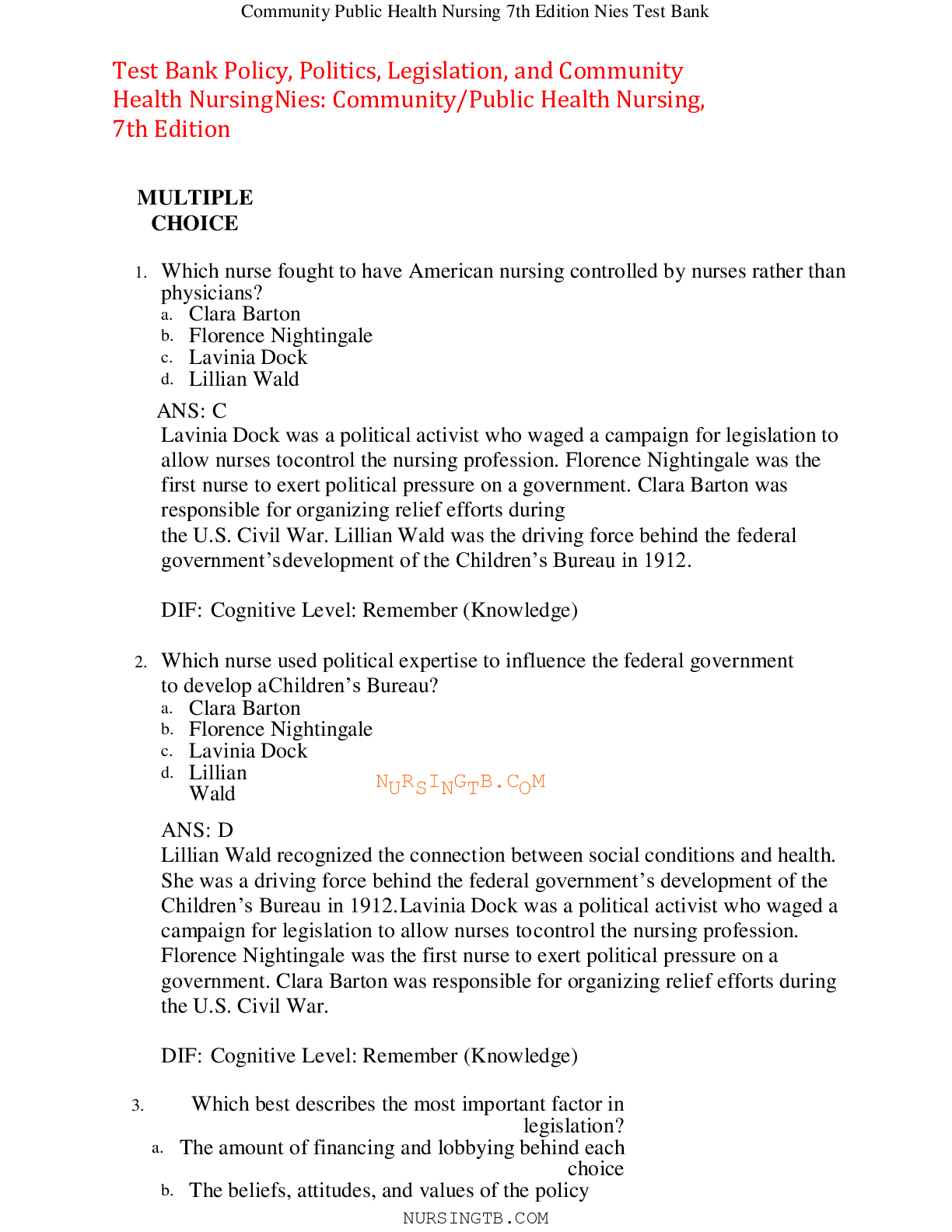


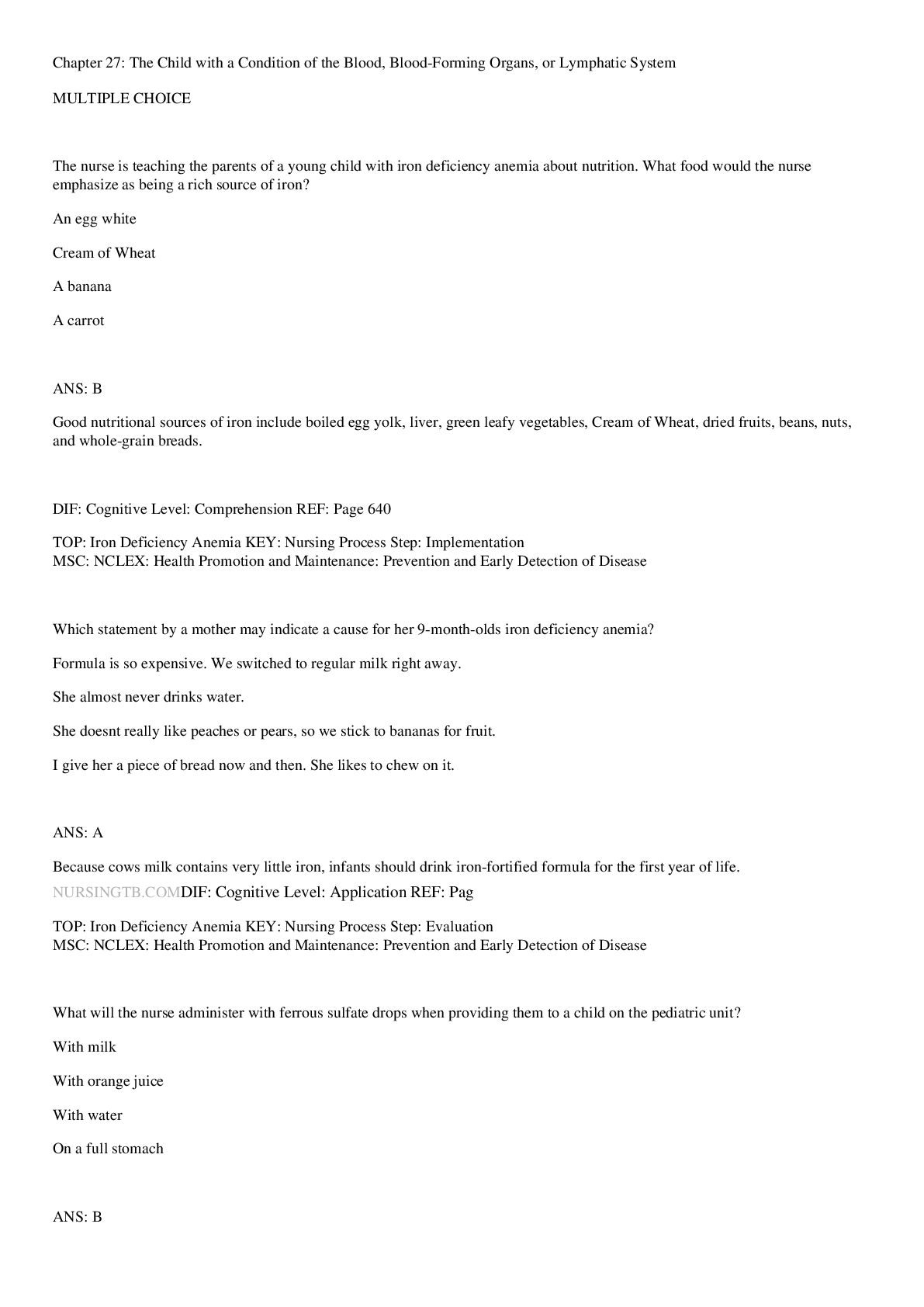



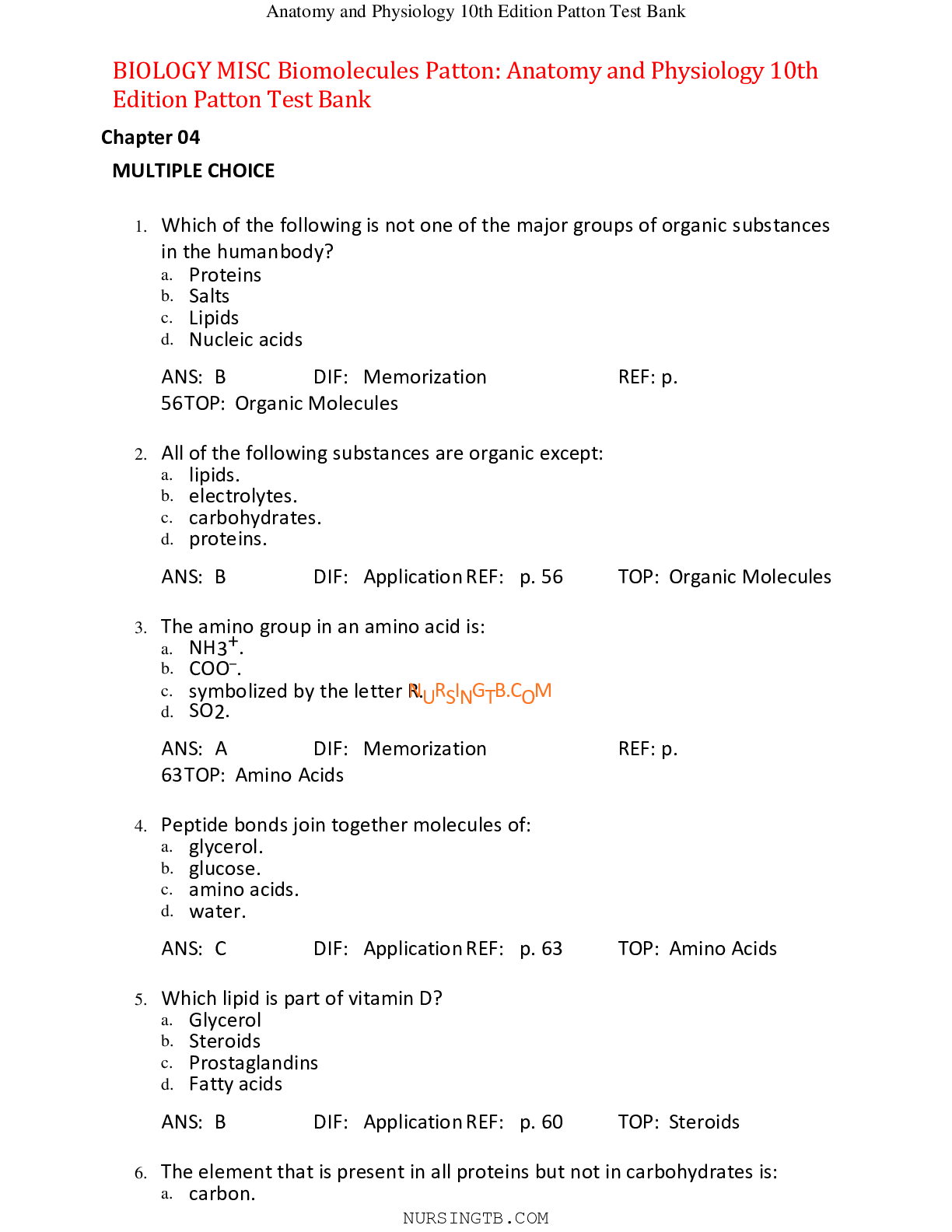







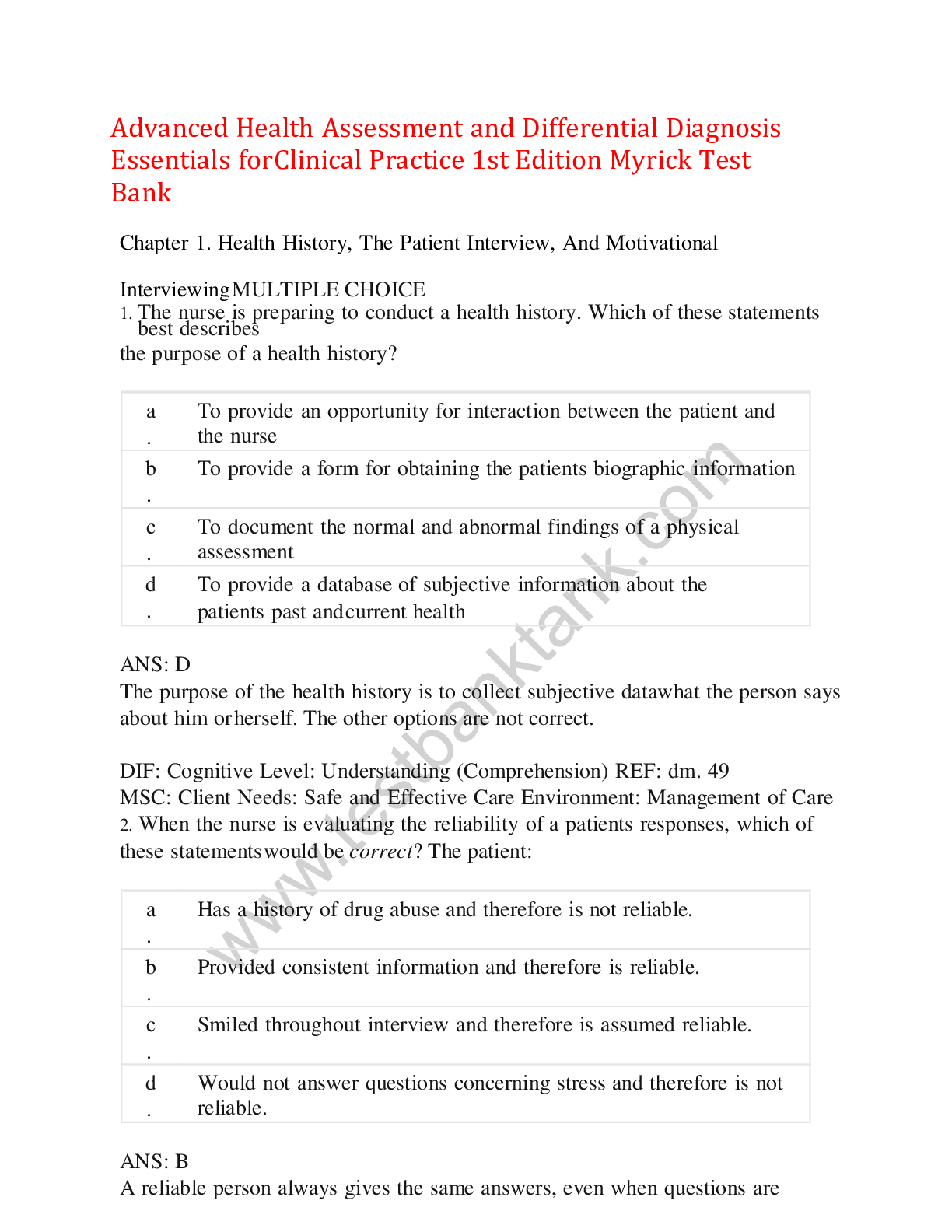
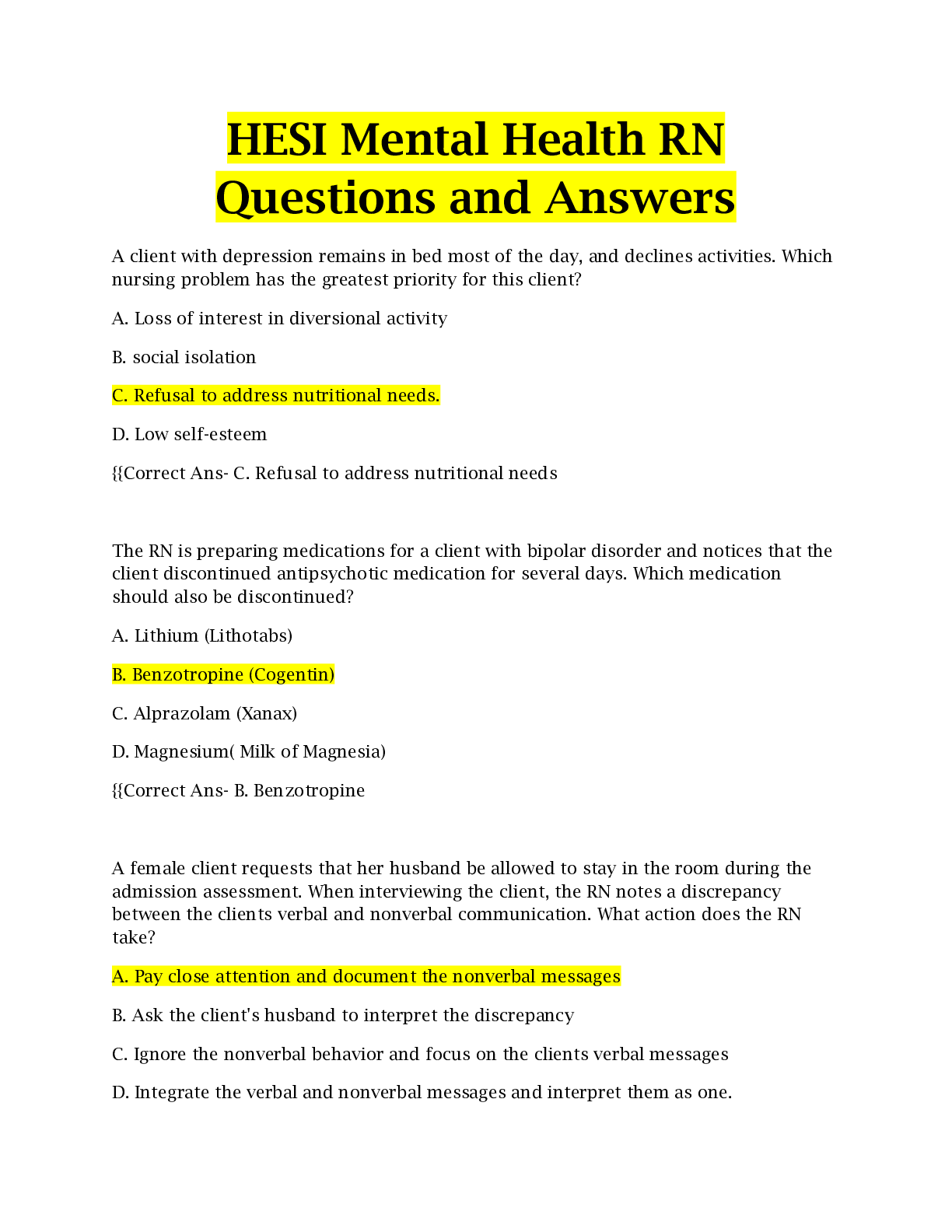



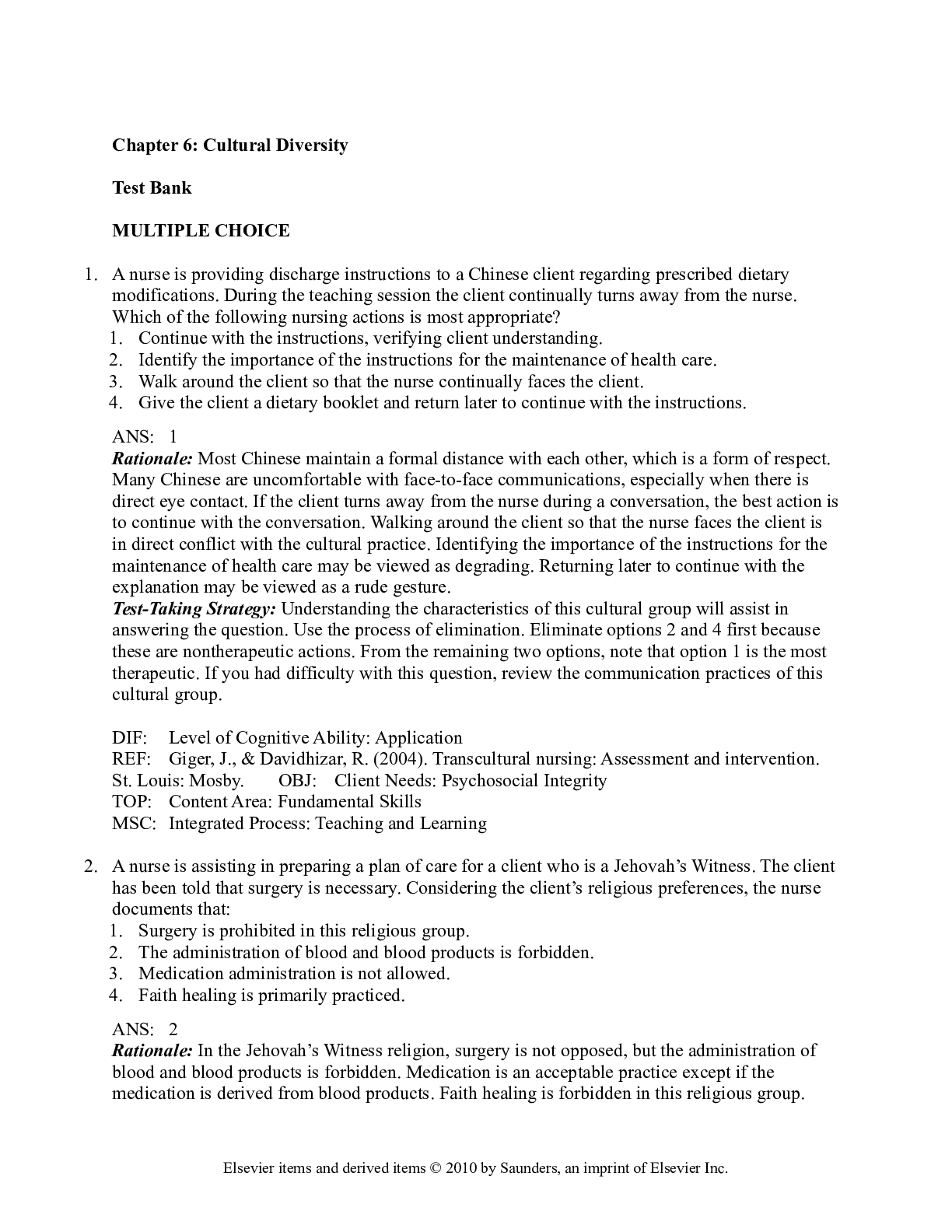
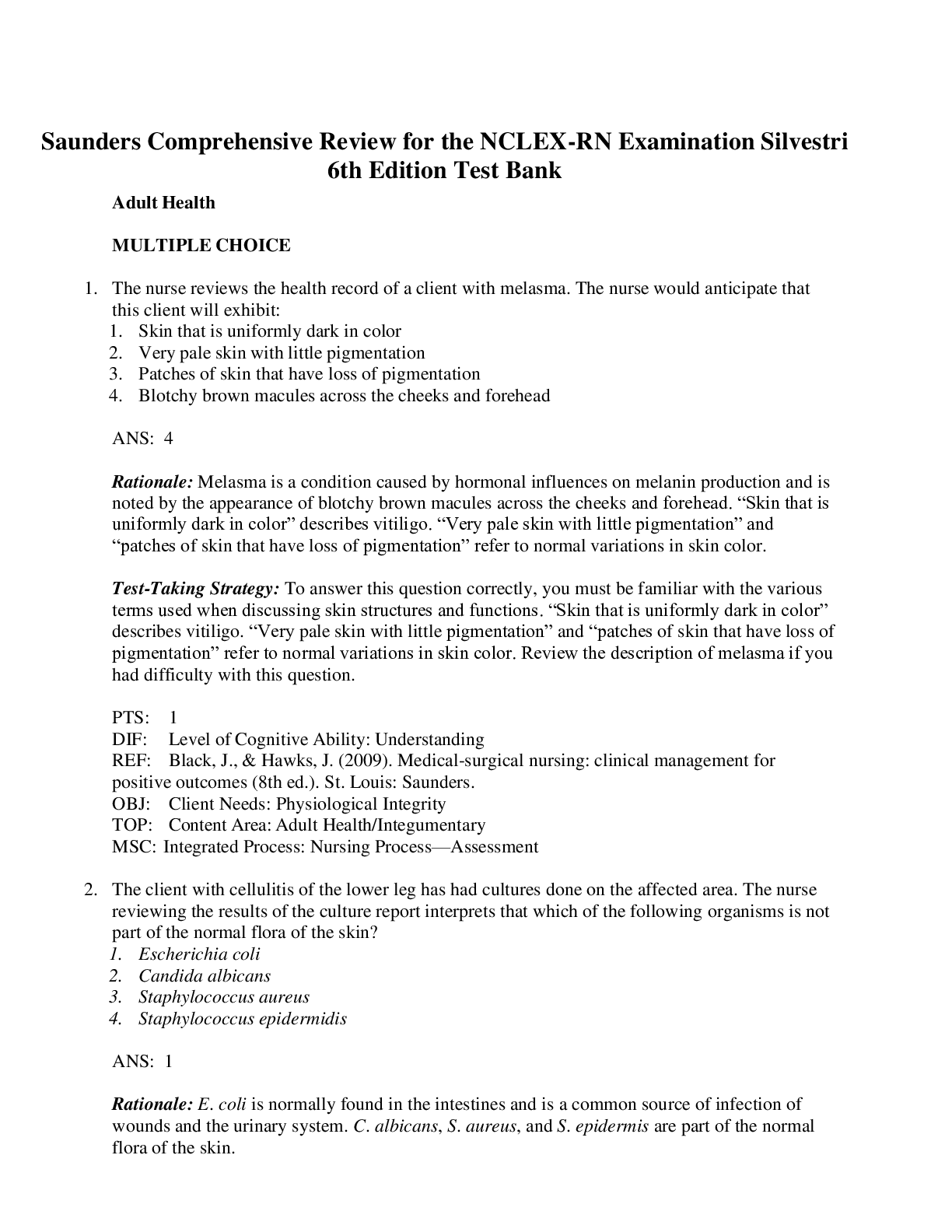
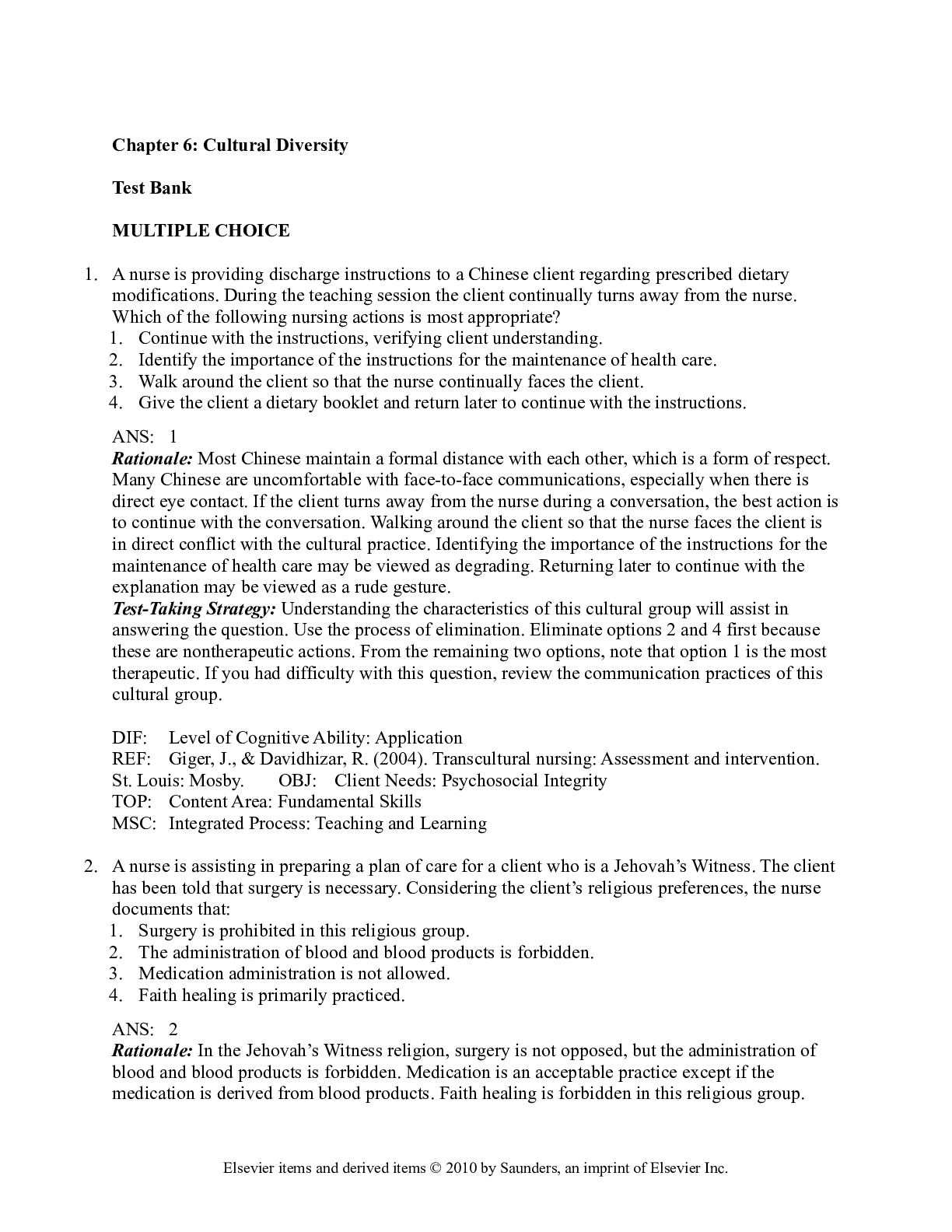

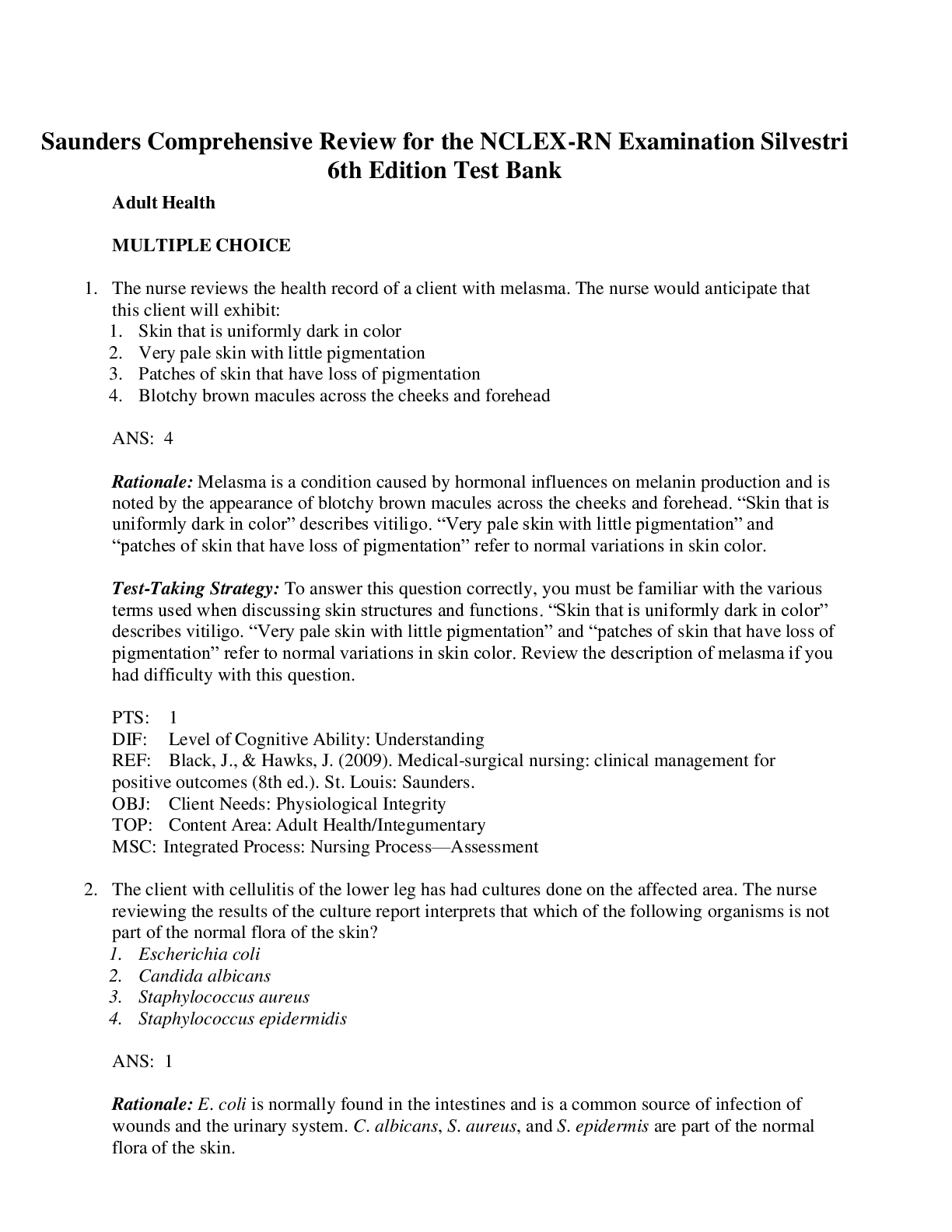
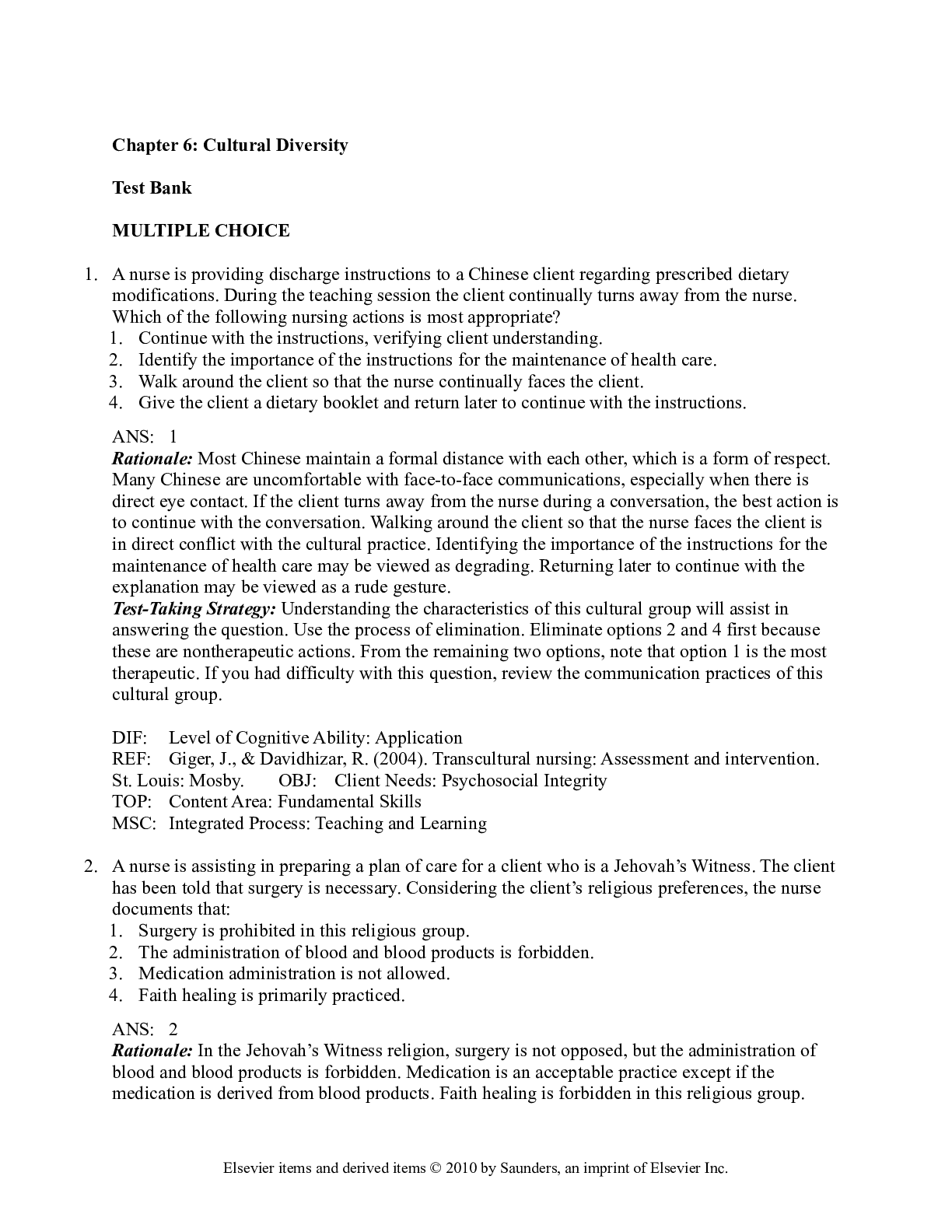


.png)
